牛津初中英语8BUnit5教材分析
- 格式:doc
- 大小:131.00 KB
- 文档页数:30
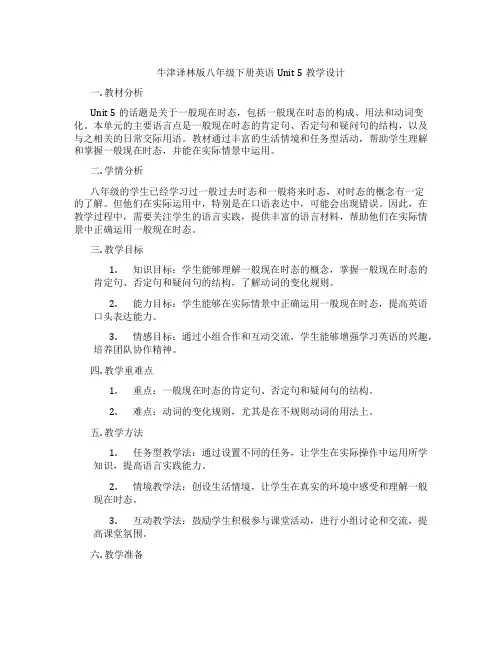
牛津译林版八年级下册英语Unit 5教学设计一. 教材分析Unit 5的话题是关于一般现在时态,包括一般现在时态的构成、用法和动词变化。
本单元的主要语言点是一般现在时态的肯定句、否定句和疑问句的结构,以及与之相关的日常交际用语。
教材通过丰富的生活情境和任务型活动,帮助学生理解和掌握一般现在时态,并能在实际情景中运用。
二. 学情分析八年级的学生已经学习过一般过去时态和一般将来时态,对时态的概念有一定的了解。
但他们在实际运用中,特别是在口语表达中,可能会出现错误。
因此,在教学过程中,需要关注学生的语言实践,提供丰富的语言材料,帮助他们在实际情景中正确运用一般现在时态。
三. 教学目标1.知识目标:学生能够理解一般现在时态的概念,掌握一般现在时态的肯定句、否定句和疑问句的结构,了解动词的变化规则。
2.能力目标:学生能够在实际情景中正确运用一般现在时态,提高英语口头表达能力。
3.情感目标:通过小组合作和互动交流,学生能够增强学习英语的兴趣,培养团队协作精神。
四. 教学重难点1.重点:一般现在时态的肯定句、否定句和疑问句的结构。
2.难点:动词的变化规则,尤其是在不规则动词的用法上。
五. 教学方法1.任务型教学法:通过设置不同的任务,让学生在实际操作中运用所学知识,提高语言实践能力。
2.情境教学法:创设生活情境,让学生在真实的环境中感受和理解一般现在时态。
3.互动教学法:鼓励学生积极参与课堂活动,进行小组讨论和交流,提高课堂氛围。
六. 教学准备1.教学课件:制作课件,展示一般现在时态的肯定句、否定句和疑问句的结构,以及动词变化规则。
2.教学素材:准备与教材相关的生活情境图片、视频等,用于展示和练习。
3.练习题:设计一些练习题,用于巩固所学知识。
七. 教学过程1.导入(5分钟)通过提问方式引导学生回顾已知的一般过去时态和一般将来时态,为新课的学习做好铺垫。
2.呈现(10分钟)利用课件展示一般现在时态的肯定句、否定句和疑问句的结构,以及动词变化规则。
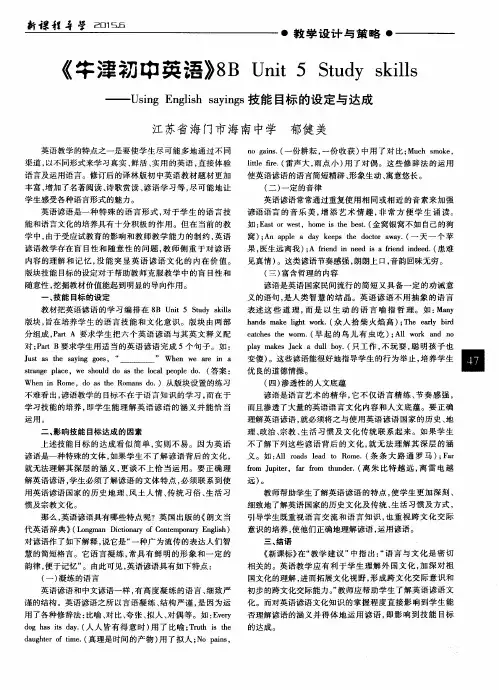
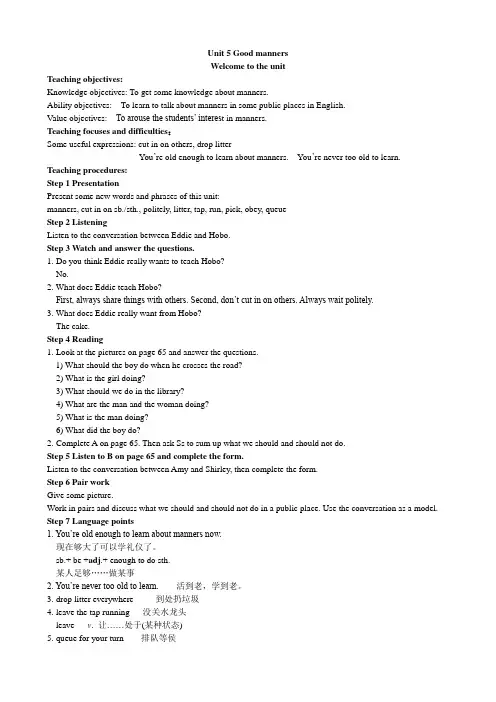
Unit 5 Good mannersWelcome to the unitTeaching objectives:Knowledge objectives: To get some knowledge about manners.Ability objectives: To learn to talk about manners in some public places in English.Value objectives: To arouse the students’ interes t in manners.Teaching focuses and difficulties:Some useful expressions: cut in on others, drop litterYou’re old enough to learn about manners. You’re never too old to learn. Teaching procedures:Step 1 PresentationPresent some new words and phrases of this unit:manners, cut in on sb./sth., politely, litter, tap, run, pick, obey, queueStep 2 ListeningListen to the conversation between Eddie and Hobo.Step 3 Watch and answer the questions.1. Do you think Eddie really wants to teach Hobo?No.2. What does Eddie teach Hobo?First, always share things with others. Second, don’t cut in on others. Always wait politely.3. What does Eddie really want from Hobo?The cake.Step 4 Reading1. Look at the pictures on page 65 and answer the questions.1) What should the boy do when he crosses the road?2) What is the girl doing?3) What should we do in the library?4) What are the man and the woman doing?5) What is the man doing?6) What did the boy do?2. Complete A on page 65. Then ask Ss to sum up what we should and should not do.Step 5 Listen to B on page 65 and complete the form.Listen to the conversation between Amy and Shirley, then complete the form.Step 6 Pair workGive some picture.Work in pairs and discuss what we should and should not do in a public place. Use the conversation as a model. Step 7 Language points1. You’re old enough to learn about manners now.现在够大了可以学礼仪了。
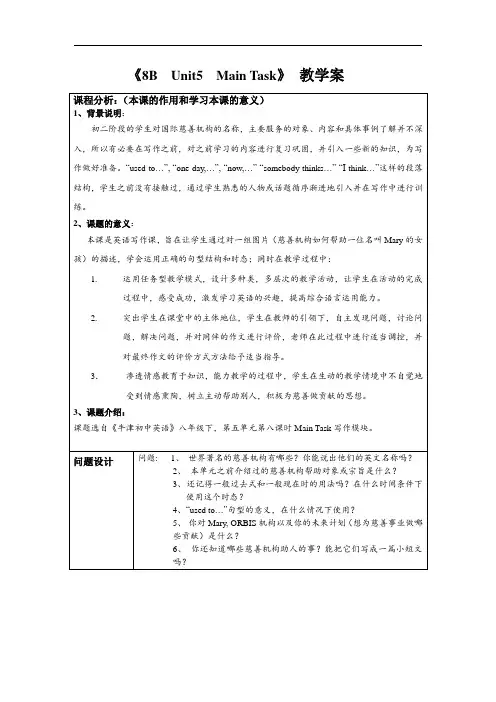
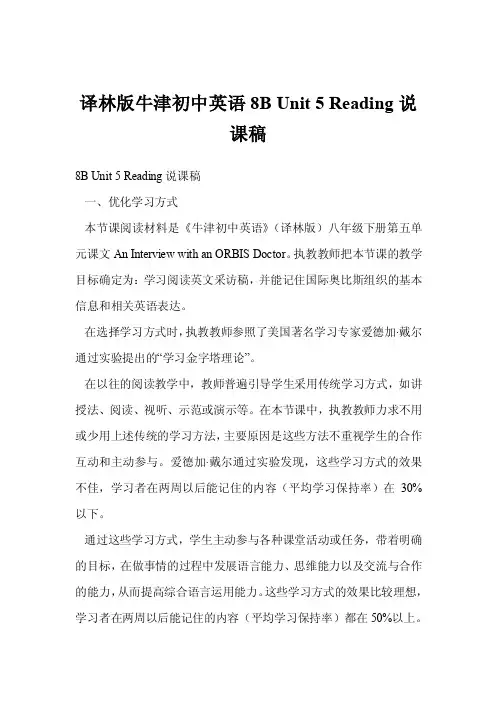
译林版牛津初中英语8B Unit 5 Reading说课稿8B Unit 5 Reading说课稿一、优化学习方式本节课阅读材料是《牛津初中英语》(译林版)八年级下册第五单元课文An Interview with an ORBIS Doctor。
执教教师把本节课的教学目标确定为:学习阅读英文采访稿,并能记住国际奥比斯组织的基本信息和相关英语表达。
在选择学习方式时,执教教师参照了美国著名学习专家爱德加·戴尔通过实验提出的“学习金字塔理论”。
在以往的阅读教学中,教师普遍引导学生采用传统学习方式,如讲授法、阅读、视听、示范或演示等。
在本节课中,执教教师力求不用或少用上述传统的学习方法,主要原因是这些方法不重视学生的合作互动和主动参与。
爱德加·戴尔通过实验发现,这些学习方式的效果不佳,学习者在两周以后能记住的内容(平均学习保持率)在30%以下。
通过这些学习方式,学生主动参与各种课堂活动或任务,带着明确的目标,在做事情的过程中发展语言能力、思维能力以及交流与合作的能力,从而提高综合语言运用能力。
这些学习方式的效果比较理想,学习者在两周以后能记住的内容(平均学习保持率)都在50%以上。
二、优化教学模式当前,中小学英语阅读教学中普遍采用整体教学模式。
该模式盛行于20世纪90年代初,强调先对文章进行宏观把握,了解文章的主要内容和整体特点,然后再深入分析各个部分。
但是,有些教师不顾实际情况,生搬硬套,机械地运用整体阅读教学模式,一个环节不敢少,一个步骤不颠倒,这种固步自封的做法导致阅读课教学环节雷同的现象非常严重,几乎每节阅读课都包括导入(Lead-in)、扫读(Scanning)、略读(Skimming)、细读(Careful Reading)、深度阅读(Further Reading)和拓展(Extension)等几个固定环节。
这种模式化的公开课根本没有学习和借鉴的价值,教师们都不愿意去听。
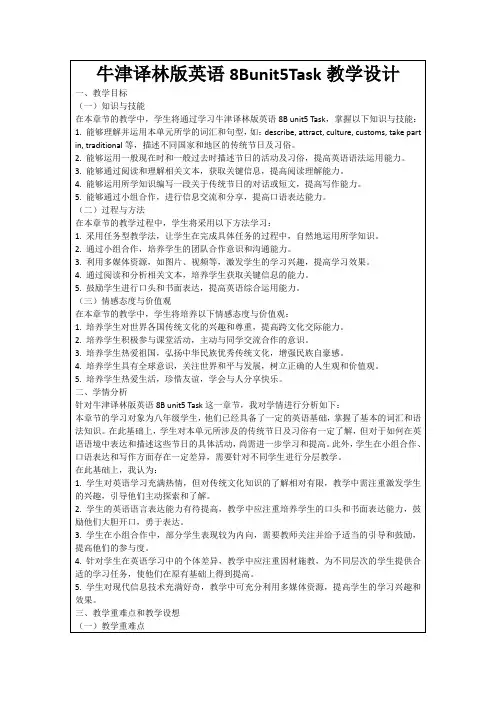
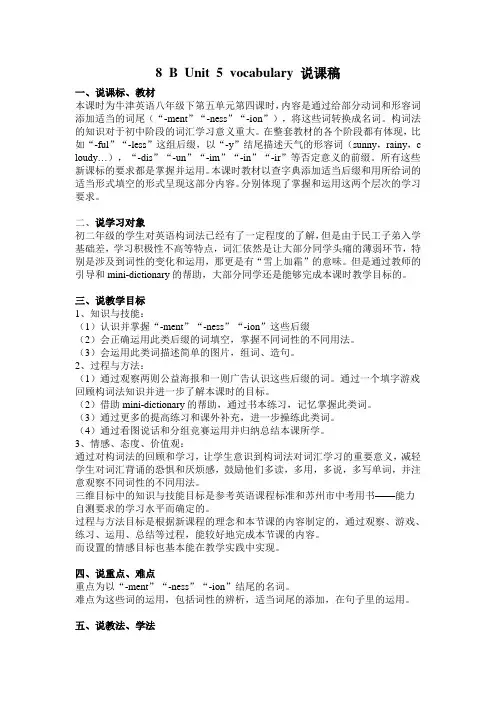
8 B Unit 5 vocabulary 说课稿一、说课标、教材本课时为牛津英语八年级下第五单元第四课时,内容是通过给部分动词和形容词添加适当的词尾(“-ment”“-ness”“-ion”),将这些词转换成名词。
构词法的知识对于初中阶段的词汇学习意义重大。
在整套教材的各个阶段都有体现,比如“-ful”“-less”这组后缀,以“-y”结尾描述天气的形容词(sunny,rainy,c loudy…),“-dis”“-un”“-im”“-in”“-ir”等否定意义的前缀。
所有这些新课标的要求都是掌握并运用。
本课时教材以查字典添加适当后缀和用所给词的适当形式填空的形式呈现这部分内容。
分别体现了掌握和运用这两个层次的学习要求。
二、说学习对象初二年级的学生对英语构词法已经有了一定程度的了解,但是由于民工子弟入学基础差,学习积极性不高等特点,词汇依然是让大部分同学头痛的薄弱环节,特别是涉及到词性的变化和运用,那更是有“雪上加霜”的意味。
但是通过教师的引导和mini-dictionary的帮助,大部分同学还是能够完成本课时教学目标的。
三、说教学目标1、知识与技能:(1)认识并掌握“-ment”“-ness”“-ion”这些后缀(2)会正确运用此类后缀的词填空,掌握不同词性的不同用法。
(3)会运用此类词描述简单的图片,组词、造句。
2、过程与方法:(1)通过观察两则公益海报和一则广告认识这些后缀的词。
通过一个填字游戏回顾构词法知识并进一步了解本课时的目标。
(2)借助mini-dictionary的帮助,通过书本练习,记忆掌握此类词。
(3)通过更多的提高练习和课外补充,进一步操练此类词。
(4)通过看图说话和分组竞赛运用并归纳总结本课所学。
3、情感、态度、价值观:通过对构词法的回顾和学习,让学生意识到构词法对词汇学习的重要意义,减轻学生对词汇背诵的恐惧和厌烦感,鼓励他们多读,多用,多说,多写单词,并注意观察不同词性的不同用法。
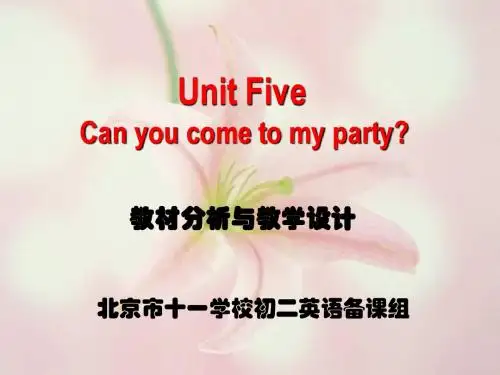

牛津初中英语8B Unit 5 International charities一、教材分析根据新课标,突出学生自主学习的主体地位原则,培养学生自主、合作、探究精神、突出语言运用能力培养的理念而设计。
《英语课程标准》是以学生“能做某事”的描述方式来设定各级目标要求的。
这就决定了我们在教学中要尽量采用“任务型”的教学途径。
在这一教学环节中,教师的任务就是根据单元和课堂教学内容和目标,给学生设计一个阶段、一个单元和每一课的学习任务、目标,并锁定任务,吸引和组织他们积极参与,通过思考、调查、讨论、交流和合作等方式,学习和使用英语,完成学习任务。
本课内容为牛津初中英语8B第五单元的阅读课,讲的是采访ORBIS的医生。
必须把握两点:一,学生并不熟悉这类课文形式;二,学生也不熟悉本文涉及的慈善机构,学生并不清楚其背景。
慈善机构在当今人们的生活中,尤其是贫困地区人们的生活中起到了越来越重要的作用。
这些机构通过不同的方式帮助世界各地的人们。
本单元就是让学生重点了解UNICEF(联合国儿童基金会)、World Vision(世界宣明会)、ORBIS(奥比斯)、Oxfam(乐施会)、Wide fund for Nature(世界自然基金会)五个国际慈善机构。
激发学生乐于助人的情怀,激励他们好好学习,为贫困地区的人们贡献自己的一份力量。
二、学生分析学生处在价值观与人生观形成的重要时期,在学生掌握一定词汇量与阅读技能的基础上,应注意培养学生乐于助人的精神,激发他们好好学习。
三、教学目标知识目标1、掌握本课中斜体部分单词并识别其他生词:affect, mostly, case, cure, medical,treatment, operation, patient, afford, skill, train, operate, indeed, proud, medicine, treat, improve, carry on, interviewer, blindness, volunteer2、理解对话内容,能够说出ORBIS的作用。
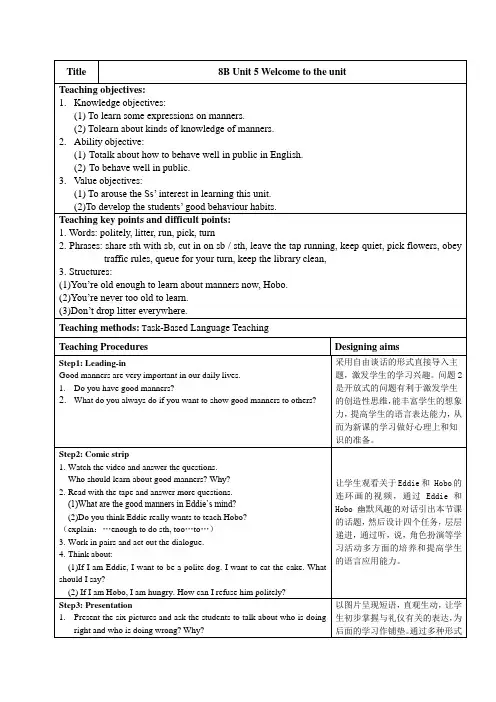
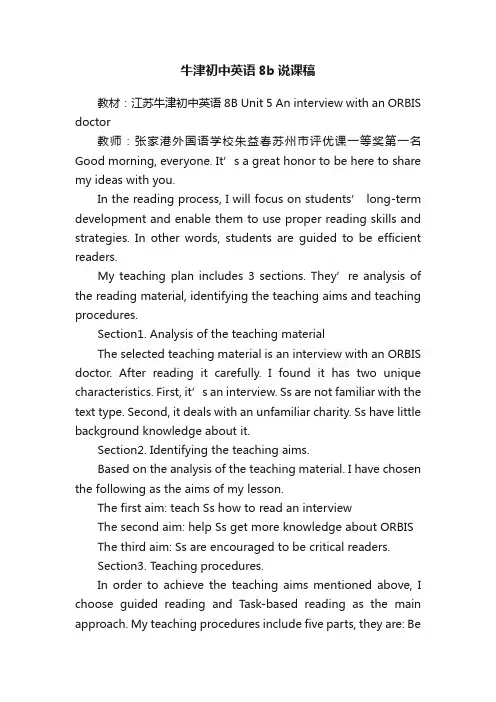
牛津初中英语8b说课稿教材:江苏牛津初中英语8B Unit 5 An interview with an ORBIS doctor教师:张家港外国语学校朱益春苏州市评优课一等奖第一名Good morning, everyone. It’s a great honor to be here to share my ideas with you.In the reading process, I will focus on students’ long-term development and enable them to use proper reading skills and strategies. In other words, students are guided to be efficient readers.My teaching plan includes 3 sections. They’re analysis of the reading material, identifying the teaching aims and teaching procedures.Section1. Analysis of the teaching materialThe selected teaching material is an interview with an ORBIS doctor. After reading it carefully. I found it has two unique characteristics. First, it’s an interview. Ss are not familiar with the text type. Second, it deals with an unfamiliar charity. Ss have little background knowledge about it.Section2. Identifying the teaching aims.Based on the analysis of the teaching material. I have chosen the following as the aims of my lesson.The first aim: teach Ss how to read an interviewThe second aim: help Ss get more knowledge about ORBIS The third aim: Ss are encouraged to be critical readers.Section3. Teaching procedures.In order to achieve the teaching aims mentioned above, I choose guided reading and Task-based reading as the main approach. My teaching procedures include five parts, they are: Bea keen reader, be a smart reader, be a sharp reader, be a critical reader and be a cultural learner.Part1. Be a keen reader.Reading begins before a book is opened. It’s important to activate Ss’ existing background knowledge and draw their attention to the topic of the text.This part consists of 3 tasks, they are: a short interview, a story introducing new words and predicting questions.In the first task, I’ll have a short interview with the monitor about eye problems of his classmates. With the task, I introduce the topic and get Ss to know the importance of asking questions in an interview.In the second task, I introduce some important new words by telling a story about a famous eye doctor.Then the third task. Before reading the material, Ss are encouraged to act as an interviewer and predict some questions which they will ask Dr Ma. With the predicting questions in mind, Ss will be eager to know what happens in the reading material.With the three tasks, I inspire students to be a keen reader.。
8B Unit 5教材分析一、教材分析本单元的主要话题是国际慈善组织。
开篇通过Eddie和Hobo这两个卡通人物妙趣横生对话,引出了一个慈善组织Oxfam,为后面的主题讨论埋下伏笔;随后介绍了世界上一些著名的慈善组织,引出了本单元的主要话题。
阅读部分通过一篇采访介绍了ORBIS这一国际著名的慈善救护组织,让学生对这些慈善组织的善行有了基本的了解。
词汇部分介绍了把动词变成形容词的后缀的用法。
语法部分包括三个内容,A部分通过ORBIS医生Dr Ma的经历介绍了Used to 的用法;B部分继续通过讨论Dr Ma介绍了与上面相似但完全不通的Be used to 的用法;C部分是对上面2部分的延伸希望以后能成为医生,在此语境中学习so….that和such…that的用法。
综合技能部分介绍了联合国儿童基金会的一些工作,通过表格和问题,学生可以检查他们从阅读文章和听力材料中的获取信息是否正确,用这些信息谈论自己为慈善组织做贡献的想法。
中心任务部分通过图片中获取的信息,让学生根据信息写一篇关于印度女孩的报告。
检测部分主要检查学生对所学语法内容的理解和运用情况。
二、总体目标通过讨论国际慈善组织ORBIS的一些情况,学习了Used to,Be used to 和so….that和such…that的用法,又了解了国内外一些著名的旅游景点,培养学生为慈善组织做贡献的想法,让他们能够帮助那些需要帮助的人。
同时,通过词汇的学习、综合技能的训练、学习技能的了解和任务的完成,使学生在各个方面的能力得以提高。
三、教学重点难点A:重点1.了解一些慈善组织的工作2.学会使用so….that和such…that3.Be used to的用法4.Used to的用法B:难点ed to和Be used to的用法和区别2.写关于慈善组织救助人的报告四、学情分析和教学理念对于慈善的话题,在上个单元中学生已经有一定的了解,本单元主要介绍了一些国际著名的慈善组织,鼓励学生加入这些组织,培养慈善互助的精神,在此环节的教学上,学生们应该具有一定的接受能力。
牛津初中英语教学设计案牛津初中英语8B Unit5 International Charities第二课时Reading 教学设计设计的基本理念:根据新课标,突出学生自主学习的主体地位原则,培养学生自主、合作、探究精神、突出语言运用能力培养的理念而设计。
《英语课程标准》是以学生“能做某事”的描述方式来设定各级目标要求的。
这就决定了我们在教学中要尽量采用“任务型”的教学途径。
在这一教学环节中,教师的任务就是根据单元和课堂教学内容和目标,给学生设计一个阶段、一个单元和每一课的学习任务、目标,并锁定任务,吸引和组织他们积极参与,通过思考、调查、讨论、交流和合作等方式,学习和使用英语,完成学习任务。
一、教材分析(一)教材的地位和作用1、单元背景分析:慈善机构在当今人们的生活中,尤其是贫困地区人们的生活中起到了越来越重要的作用。
这些机构通过不同的方式帮助世界各地的人们。
本单元就是让学生重点了解UNICEF(联合国儿童基金会)、World Vision(世界宣明会)、ORBIS(奥比斯)、Oxfam(乐施会)、Wide fund for Nature(世界自然基金会)五个国际慈善机构。
激发学生乐于助人的情怀,激励他们好好学习,为贫困地区的人们贡献自己的一份力量。
2、教材内容分析:本单元主要谈论有关慈善机构的话题。
本课是一篇阅读课文,通过学习对ORBIS一名医生的采访,了解ORBIS医生的基本工作状况。
学生通过对比学习,引出新课标语言的学习,并通过一系列的听、说、读、写活动逐步深入,不仅让学生学会用正确的语言介绍ORBIS 医生的工作情况,又能让学生了解更多关于世界贫困人口的情况,激发学生乐于助人的情怀。
所以本课是本单元的教学重点。
二、设计特色:强调学生自主学习、合作讨论和语言表达能力,不同的学生提出不同的要求,让每个层次的学生都有所收获,激发学习兴趣。
三、教案流程图:Language points Explain and examples Practice Choose the best answerShow and tellSummary What do you learn about the storyHomework Using keywords retell板书设计:Unit 5 International Charities (Reading) Questions:1、How many people does blindness affect around the world?2、How does help?3、What can people do to support ?4、What do volunteer doctor do on the plane? ……Words:affect mostly operation afford proud improve patient skill treat indeed operate ……教学反思:结合农村学生英语基础差,听说能力差,缺乏学习兴趣,两极分化严重这一特点设计了本课教学。
Teaching content: Comic strip& Welcome to the unitTeaching goalsTo introduce students to some international charitiesTo learn to use 'used to' and 'be used to'Teaching important & difficult points:Words: international \pocket \be used to \further \health careSentence patterns: You have some pocket money left.I am not used to going out before lunch.You used to be very kind to me.I‟m so weak that I can‟t walk any further.Teaching proceduresStep 1 Warming upWhat charities in China do you know of? What do they help?In this unit, we‟ll learn some international charities. What international charities do you know of?Have you ever heard of famous international charities like: ORBIS, Oxfam, UNICEF, World Vision and World Wide Fund for Nature?Step PresentationWhat do you think people in poor countries need most? Do they get help from internationalcan you do for charities? (We can donate our pocket money to them.)Oxfam needs money to carry on with their work.Who calls for donating pocket money to Oxfam? (Hobo)Will he donate his own pocket money? (No)Whose pocket money does he want to donate? (Eddie's)When does he want to go to donate money? (Right now, at lunchtime)Does Eddie agree? (Of course not)Why not? (He doesn't often go out before lunch. That is to say, he isn‟t used to going out before lunch.)What does Eddie think of Hobo? (Hobo was kind to him before, but now he isn't, That is to say, Hobo used to be kind to Eddie.)Where will Hobo take Eddie to have lunch'?Do you think Eddie is willing Lo go to Oxfam right now? Why?Step 3 ConsolidationNow read after the tape sentence by sentence.You are given five minutes to find out and write down all the useful expressions in this part.Step 4 SummaryStep 5 Homeworka. Read the comic strips and try to remember it. Try you best to act it out.b. Finish off the exercises in the Evaluation Handbook.Teaching content: Reading (I)Teaching goalsTo learn to guess meanings of new words from the contextTo learn to skim text for overall meanings and scan for detailsTo understand the structure of difficult sentencesTeaching important & difficult points:Words: cat \camera \popSentence patterns: About 80 percent of these cases can be cured or prevented.The plane is also used as a teaching centre.Many of our patients are so poor that they can‟t afford to travel to hospitalTeaching proceduresStep 1 RevisionWhat international charities do you know about?What do they do?Have you heard of ORBIS?ORBIS helps blind people in poor countries. The state of being blind is called blindness. Why does ORBIS help the blind patients? Because blindness affects many people around the world ,mostly in poor countries. But most of the cases of blindness can be prevented or cured. Why don‟t the blind go to see doctors? Because they are so poor that they c an‟t pay for medical treatment. ORBIS doctors treat them for free. They operate on/do (perform) operations on their patients. So the patients are thankful /grateful to them. How do you think ORBIS doctors feel when they help people? (They feel proud.)Step 2 PresentationStep 3 ConsolidationNow listen to the tape, and then answer the following questions:How many people around the world are affected by blindness?How many cases of blindness can be prevent or cured?Where do ORBIS doctors work?What does ORBIS need?Read the text silently again.Try to fill in the blanks in Part B2, checking your answers against your partner‟s. (Keys: operations, skills, knowledge, grateful, patients, cured, donations)Put the sentences together in Part C,, then checking the answers with your partners. (Keys: 1e, 2f, 3a, 4c, 5d, 6b; 1charity, 2blind, 3eye, 4hospital, 5doctors, 6treat, 7teach,8operations)Now read after the tape sentence by sentence. Pay attention to the sense groups within the sentences.Step 4 SummaryAsk students to tell if the following statements are “True” or “False” according to the text.1. Blindness affects about 45 million people around the world, mostly in western countries. F2. Many blind people have no money for medical treatment. T3. Local doctors perform operations on the plane instead or in the hospital because it is more comfortable on the plane. F4. Dr. Ma used to do one or two operations, a day. F5. Patients are very grateful to ORBIS doctors. TStep 5 Homeworka. Read after the tape five times. Your parent's signature is neededb. Finish the exercises in the Evaluation Handbook.8B Unit Five International charitiesPeriod ThreeTeaching content: Reading (II)Teaching goals:1.Check understanding by linking parts of sentences.2.Summarize information by completing notes.Teaching important & difficult points:Understand and grasp some phrases and sentencesTeaching Procedures:Step 1. RevisionCheck the homeworkStep 2.Reading1.Let students read the conversation together2.Ask two students to read the conversation as Dr Ma and the interviewStep3. PracticeLet Sts. finish PartC2, ask volunteers to read out one sentence each.Step nguage points:affect Smoking affects your health. 吸烟影响健康。
牛津译林版八年级英语下册8BU5 Grammar教学设计(公开课)一. 教材分析本课选自牛津译林版八年级英语下册8BU5,主题是关于一般现在时态的用法。
通过本课的学习,学生将能够掌握一般现在时态的构成、用法及主谓一致等语法知识。
教材通过丰富的语境和真实的例子,帮助学生理解和运用一般现在时态。
二. 学情分析八年级的学生已经学习过一般现在时态,对本课的内容有一定的了解。
但部分学生可能对主谓一致等语法规则掌握不牢固,需要通过本课的学习进一步巩固。
同时,学生对于英语语法的兴趣和积极性需要激发,以便更好地参与课堂活动。
三. 教学目标1.知识目标:学生能够掌握一般现在时态的构成、用法及主谓一致等语法知识。
2.能力目标:学生能够在实际语境中正确运用一般现在时态,提高英语表达能力。
3.情感目标:通过本课的学习,学生能够增强对英语语法的兴趣,提高学习积极性。
四. 教学重难点1.重点:一般现在时态的构成和用法。
2.难点:主谓一致和一般现在时态在实际语境中的运用。
五. 教学方法1.情境教学法:通过创设真实的语境,让学生在实际情境中感知和运用一般现在时态。
2.任务型教学法:通过完成各种任务,激发学生的学习兴趣,提高参与度。
3.互助合作学习:鼓励学生之间相互讨论、交流,共同解决问题。
六. 教学准备1.教材:牛津译林版八年级英语下册。
2.多媒体设备:电脑、投影仪等。
3.教学素材:相关图片、PPT、练习题等。
七. 教学过程1.导入(5分钟)利用图片和简短的视频,引导学生回顾一般现在时态的用法,为新课的学习做好铺垫。
2.呈现(10分钟)通过PPT展示一般现在时态的构成和用法,让学生初步感知和理解。
同时,讲解主谓一致的规则。
3.操练(10分钟)设计一些简单的练习题,让学生分组进行练习,及时巩固所学知识。
教师巡回指导,解答学生的疑问。
4.巩固(10分钟)创设一个真实的语境,让学生分角色扮演,用一般现在时态进行对话。
鼓励学生大胆开口,提高实际运用能力。
八年级英语Integrated skills(牛津英语8B Unit5) 说课稿一、说教材和学生今天我说课的内容是8B Unit 5 International Charities 的Integrated skills部分。
《Fun with English》(牛津初中英语)8B 有两个模块(Module)、六个单元(Unit),每个模块有三个单元,各单元包括:卡通漫画(Comic strip)、导入(Welcome to the unit)、阅读(Reading)、词汇(Vocabulary)、语法(Grammar)、综合技能(Integrated skills)、学习技巧/语音(Study skills/Pronunciation)、中心任务(Main task)、检测(Checkout)九个部分组成。
整个教材按照“话题—功能—结构—任务”相结合的思路编排,以话题为主线,任务为主导,辅以功能和结构项目,有效培养学生综合运用英语的能力。
8B Unit 5内容就是介绍国际慈善机构,主题是慈善机构,重点是关于各个慈善机构的帮助对象以及引导学生们将部分零花钱捐给所支持的慈善机构,帮助需要帮助的人。
话题内容联系社会生活,贴近生活实际,富有时代气息,体现时代精神。
通过卡通漫画(Comic strip)、导入(Welcome to the unit)、阅读(Reading)、词汇(Vocabulary)、语法(Grammar)五个环节学习,学生基本掌握本单元的词汇、句型、语法和话题内容等语言知识,到Integrated skills(综合技能)这一课时,已经初步具有应用语言的技能,语言知识学习从认知过程转入实践运用阶段,所以Integrated skills(综合技能)围绕与本单元主题相关的任务,将听、说、读、写糅合在一起进行综合练习,以提高学生综合应用语言的能力。
通过对本课的分析,我认为本课的学习目标为:熟悉各个国际慈善机构的名称;应用一段描述中所提供的主要信息并通过听掌握相关的补充信息;通过完成一段描述并掌握图标来培养精听技能。
8B Unit 5教材分析一、教材分析本单元的主要话题是国际慈善组织。
开篇通过Eddie和Hobo这两个卡通人物妙趣横生对话,引出了一个慈善组织Oxfam,为后面的主题讨论埋下伏笔;随后介绍了世界上一些著名的慈善组织,引出了本单元的主要话题。
阅读部分通过一篇采访介绍了ORBIS这一国际著名的慈善救护组织,让学生对这些慈善组织的善行有了基本的了解。
词汇部分介绍了把动词变成形容词的后缀的用法。
语法部分包括三个内容,A部分通过ORBIS医生Dr Ma的经历介绍了Used to 的用法;B部分继续通过讨论Dr Ma介绍了与上面相似但完全不通的Be used to 的用法;C部分是对上面2部分的延伸希望以后能成为医生,在此语境中学习so….that和such…that的用法。
综合技能部分介绍了联合国儿童基金会的一些工作,通过表格和问题,学生可以检查他们从阅读文章和听力材料中的获取信息是否正确,用这些信息谈论自己为慈善组织做贡献的想法。
中心任务部分通过图片中获取的信息,让学生根据信息写一篇关于印度女孩的报告。
检测部分主要检查学生对所学语法内容的理解和运用情况。
二、总体目标通过讨论国际慈善组织ORBIS的一些情况,学习了Used to,Be used to 和so….that和such…that的用法,又了解了国内外一些著名的旅游景点,培养学生为慈善组织做贡献的想法,让他们能够帮助那些需要帮助的人。
同时,通过词汇的学习、综合技能的训练、学习技能的了解和任务的完成,使学生在各个方面的能力得以提高。
三、教学重点难点A:重点1.了解一些慈善组织的工作2.学会使用so….that和such…that3.Be used to的用法4.Used to的用法B:难点ed to和Be used to的用法和区别2.写关于慈善组织救助人的报告四、学情分析和教学理念对于慈善的话题,在上个单元中学生已经有一定的了解,本单元主要介绍了一些国际著名的慈善组织,鼓励学生加入这些组织,培养慈善互助的精神,在此环节的教学上,学生们应该具有一定的接受能力。
教学中采用Role playing,Practicing,Cooperating,Scanning和listening for specific information的学习策略,利用教学图片以及制作多媒体课件来展开课题Work alone,Pairwork,Group work的口语交际活动。
词汇教学部分可以通过实物或图片进行,引导学生进行描述,增加对词汇的理解和感受;听力和口语教学—角色扮演模仿对话、写关键词或复述对话、短文为主,加强对主要信息的获取和输出;阅读教学以写关键词(信息)、复述短文、模仿描述等为主;写作教学以填词造句、模仿写作为主;语法教学以总结规律、模仿操练为主,并做到经常复习。
五、课时安排本单元共计安排十个课时。
具体安排如下:Comic strip and Welcome: one period Reading:two periods Vocabulary:one period Grammar:two periods Integrated skills:one period Study skills:one period Main task: one period Check out: one periodPeriod 1 Comic strip and Welcome to the unitTeaching aims: Have the Ss know sth. about international charities and try to talk their favorite charities.To introduce Ss to some international charities. To prioritize needs in poor countries.Teaching procedures:Step1. GreetingsStep2. Free talk1.Greet with the teacher freely. !2.Have a free talk with the students. Revise something learned before, especially Have a free talk with the teacher.3.Some charities in china. Do you know any charities in china?What are they? “What do they help?”Answer the questions.4. Listen and arouse their interestStep3.Presentation1.Talk about what life is like for people who are very poor.2. Ask Ss to think about how their lives might be different if they had almost no money.3. Divide the class into pairs. Ask Ss to look at the list of items in Part B and decide which items are the most important and which items are the least important for people in poor countries.4.Talk about international charities and the work they do. Ask Ss Which international charities they know and write a list on the board.5. Listen and try to understand what teacher has said.6. 1.Make some crazy suggestions to get the students’ attention. Try to adapt the initial questions to arouse students’ interest. There are many international charities helping needy people and worthy causes all over the world.7. Look at some symbols in Part A. T uses these symbol to present the following charities.8. Listen and understand what the teacher said: the ideas about thingsgoing on now, at present, at the moment, right now.9. Talk about international charities and the work they do. Ask Ss Which international charities they know and write a list on the board. Talk about international charities10. Tell Ss To look at the symbols in Part A and the names of the charities in the box. Ask them to write the names of the charities under the pictures.11.Tell them to try to do the task on their own first, and then compare answers with a partner. Write the names of the charities under the pictures.12. Ss know sty. About international charities and try to talk their favorite charities.Talk about their favorite charities.Step4. Comic strip.1.Tell Ss to read the comic strip, then ask some questions to check understanding, e.g., What does Oxfam need? (donations)What is Hobo going to do? (Donate money)2.Ask Ss how they feel about donating money to charities. Find out how much they know about why it is done and what the money is used for. Ask them what else they would consider donating. read the comic strip3. Ask Ss to read with partner and try to perform Hobo and Eddie according to the comic strip. Then ask three or four pairs to perform this conversation before the class. read with partner4. Pay attention to some useful expressions:1)…. left T: What doe “left” mean here? e.g. There are only three2) be used to doing e.g. He is used to getting up before 6:30 every morning.3) Too…to… e.g. He is too weak to walk any further.Make some notes课时练一一、翻译下列短语1.国际慈善性组织2.习惯于做某事3.过去常常做某事4.吃丰盛的午餐二、选择填空A)1.________works to help blind people.2. works to protect the environment and animal shelter.3. works to fund development projects in poor areas around the world.4. works to help people in poor countries.5. works to provide children with basic food, health and educational needs.B) 选用所给句子完成对话Kitty: I used to spend all my pocket money on stickers. 1Daniel: I used to buy some story-books. Now, I try to save some money to give to charities.Kitty: 2Daniel: ORBIS. 3 I think it is very sad if you can't see anything. What about you?Kitty: I often donate money to UNICEF. 4Daniel: Sometimes I also donate money to it with my classmate. 5Kitty: Yes, let's save our money to help the people in need.三、单项选择( )1.I'm not used to to in that rude way.A. be spokenB. being spokenC. speakD. speaking( )2.Is there you'd like to say?A. something elseB. else somethingC. else anythingD. anything else( )3.In the story every day one of the smaller animals was madethe tiger something to eat.A. bringB. to bringC. broughtD. bringing( )4.They raise money by selling Christmas cards and other fond-raising activities.A. organizeB. organizingC. to organizeD. organized( )5.Life isn't so easy here as it be.A. is used toB. was used toC. used toD. used( )lie does and they are thankful to her.A. a important workB. an important workC. an important jobD. a important jobPeriod 2 Reading(I)Teaching aims:1. Understand open questions used in an interview.2. Infer general meaning from title and context.3. Predict the meanings of specific words from close context4. Check understanding by linking parts of sentences.5. Summarize information by completing notes.Teaching procedures:Step1Ask if Ss. Know anyone who works for a charity, and if so, which charity and what they do.Step2T writes “ORBIS” on the blackboard.Ask Ss what they know about ORBISor whether they have heard of it before doing the Welcome to the unit exercise. Talk about blindness and how it might affect a person’s life.Step 3Listen to the tape about the reading, and then ask Ss to read the text by themselves again.Step 4Ask Ss some questions to check their understanding and encourage sts. to think more about the topic.Step 5Ask Ss to do pair work. They practice the interview and perform Dr Ma and the interviewer. ( Three or four pairs perform the interview.)Step 6Ask Ss to find out the language points in the conversation and analyze them.Step7 Phrasespeople around/all over the world 全世界的人们mostly in poor countries 大多在贫困国家80 percent of the cases of blindness 80%的失明病例medical treatment药物治疗/医疗a flying eye hospital一个飞行科医院volunteer doctors 志愿者医生perform/do operations 施行手术be used as a teaching centre 被用作一个教学中心afford to do sth 付得起做某事的钱learn about eye operations 学习有关眼科手术watch the operations on video 通过录像观看手术by training local doctors and nurses 通过培训当地的医生和护士during my last visit在我上一次访问过程中operate on sb = do/perform an operation on sb给某人做手术such an important job 如此重要的一项工作be grateful/thankful to sb for sth. 因为某事而感激某人课时练二一、翻译下列短语1.一家飞行眼科医院_____________ 2.医疗___________________3.教学中心____________________ 4.施行手术___________________ 5.很多病人___________________ 6.现代医学___________________ 7.支持某人工作_________________ 8.继续进行某事_______________ 9.偏僻的地区________________ 10.给某人做手术_______________ 二、单项选择( )1.UNICEF wants to make the world a place for children.A. betterB. goodC. wellD. the best( )2.Amy said most doctors and nurses work .A. in the hospitalB. in the hospitalsC. in hospitalsD. in big hospital( )3.We hope people will support our work by to ORBIS.A. sending donationsB. send donationsC. sending donationD. send donation( )4.Our computer teacher taught us new .A. skills and knowledgeB. skills and knowledgesC. skill and knowledgeD. skill and knowledge( )5.My father in a shoe factory.A. used to workingB. used to worksed to workD. is used to work( )6.Dr. Lin was not on so many patients every day.A. used to workingB. used to worksC. used to workD. used working( )7.We should take some actions to people from wild animals.A. prevent, killB. prevent, killingC. preventing, killD. prevent, to kill( )8.Many people eye problems visit the ORBIS plane.A. onB. withC. haveD. has( )9.The weather is bad. But they decided to with their work.A. carry offB. carry onC. carry outD. carry( )10.Doctors give operations them help them see again.A. to; toB. on; toC. to; forD. for; to三、根据中文完成句子1.他们通过组织一些募集资金的活动募捐钱款。